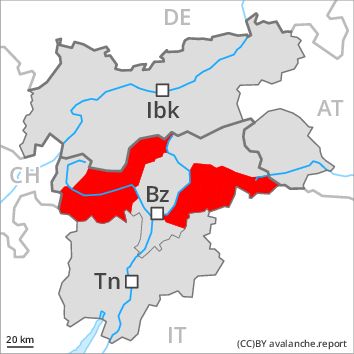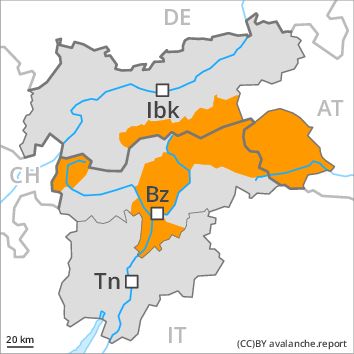Regions
Texel Mountains, Gröden Dolomites, Prags Dolomites, Sexten Dolomites, Ortler Range, Schnals Ridge, Southern Stubai Alps, Ulten Valley, Saldurn-Mastaun Ridge

Danger level
Avalanche Problem
Gliding snow above 2500m, N-NE-E-SE-S-SW-W-NW
Wind-drifted snow above 2200m, N-NE-E-W-NW

Gliding snow represents the main danger. Fresh wind slabs require caution, in particular above approximately 2200 m.
On steep grassy slopes more gliding avalanches are possible, even quite large ones, in the regions exposed to heavier precipitation especially, in particular in the east. In addition the deep wind slabs of the last few days above approximately 2200 m are prone to triggering now as before. Avalanches can be released, even by a single winter sport participant and reach large size in isolated cases. The prevalence of avalanche prone locations and likelihood of triggering will increase with altitude. As a consequence of the sometimes strong southerly wind more natural avalanches are possible, even very large ones in isolated cases, in particular in shady places that are protected from the wind at high altitudes and in high Alpine regions. Snow sport activities outside marked and open pistes call for very extensive experience in the assessment of avalanche danger and great restraint.
Snowpack
dp 2: gliding snow
dp 6: cold, loose snow and wind
In particular in the Dolomites, in the Ortler Range and in the Passeier Tal 20 to 30 cm of snow, and even more in some localities, will fall. The wind will be strong adjacent to ridgelines. In some places wind slabs are lying on soft layers, especially at elevated altitudes. The fresh wind slabs are in many cases thick and can in some cases be released easily especially at their margins. The snowpack will be moist at low and intermediate altitudes.
Tendency
The avalanche danger will persist.
